radiator MERCEDES-BENZ GL-Class 2014 X166 Owner's Manual
[x] Cancel search | Manufacturer: MERCEDES-BENZ, Model Year: 2014, Model line: GL-Class, Model: MERCEDES-BENZ GL-Class 2014 X166Pages: 462, PDF Size: 32.46 MB
Page 14 of 462
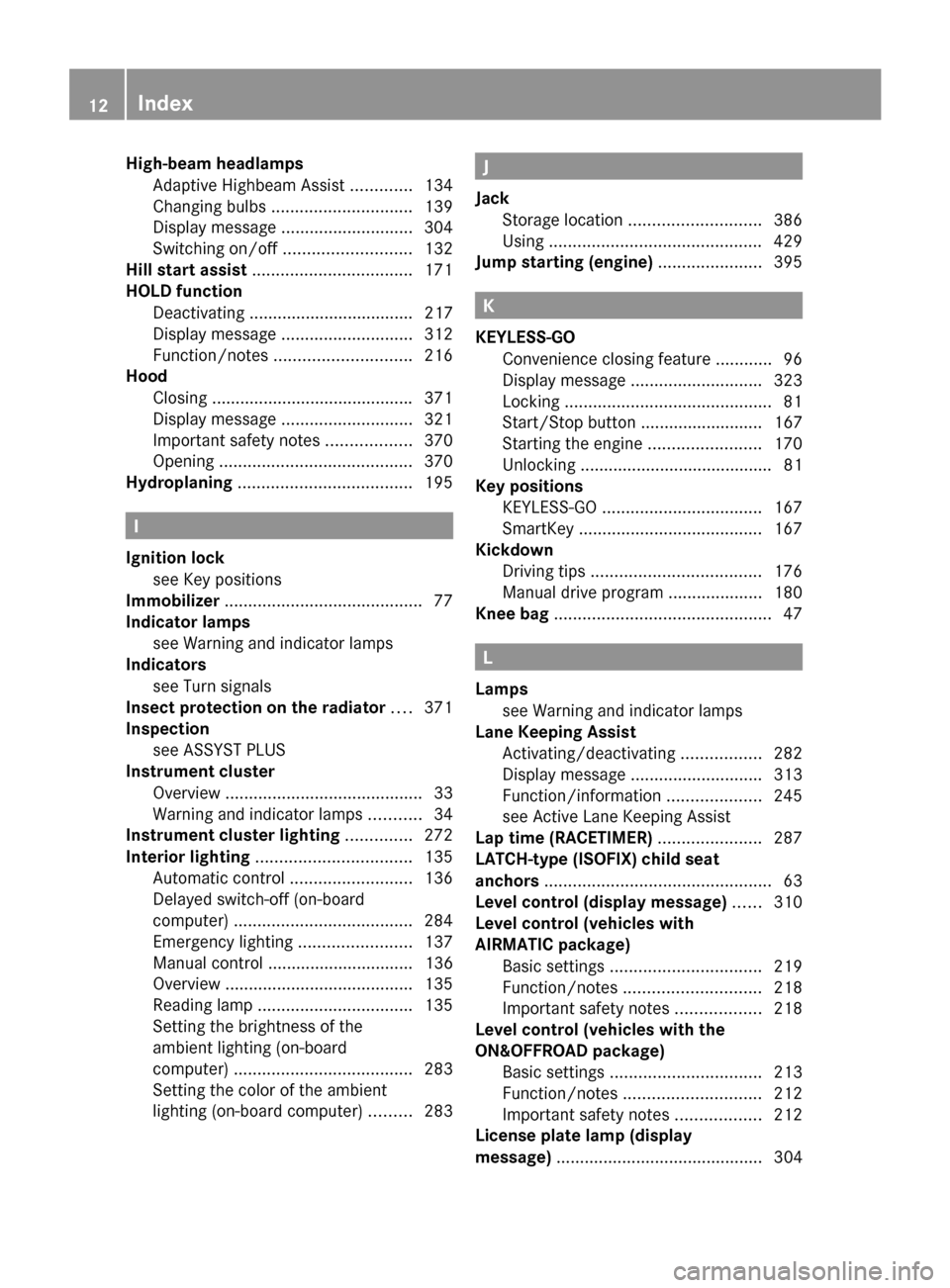
High-beam headlamps
Adaptive Highbeam Assist .............134
Changing bulbs .............................. 139
Display message ............................ 304
Switching on/off ........................... 132
Hill start assist .................................. 171
HOLD function Deactivating ................................... 217
Display message ............................ 312
Function/notes ............................. 216
Hood
Closing .......................................... .371
Display message ............................ 321
Important safety notes ..................370
Opening ......................................... 370
Hydroplaning ..................................... 195I
Ignition lock see Key positions
Immobilizer .......................................... 77
Indicator lamps see Warning and indicator lamps
Indicators
see Turn signals
Insect protection on the radiator ....371
Inspection see ASSYST PLUS
Instrument cluster
Overview .......................................... 33
Warning and indicator lamps ...........34
Instrument cluster lighting ..............272
Interior lighting ................................. 135
Automatic control ..........................136
Delayed switch-off (on-board
computer) ...................................... 284
Emergency lighting ........................137
Manual control ............................... 136
Overview ........................................ 135
Reading lamp ................................. 135
Setting the brightness of the
ambient lighting (on-board
computer) ...................................... 283
Setting the color of the ambient
lighting (on-board computer) .........283 J
Jack Storage location ............................ 386
Using ............................................. 429
Jump starting (engine) ......................395 K
KEYLESS-GO Convenience closing feature ............96
Display message ............................ 323
Locking ............................................ 81
Start/Stop button .......................... 167
Starting the engine ........................170
Unlocking ......................................... 81
Key positions
KEYLESS-GO .................................. 167
SmartKey ....................................... 167
Kickdown
Driving tips .................................... 176
Manual drive program ....................180
Knee bag .............................................. 47 L
Lamps see Warning and indicator lamps
Lane Keeping Assist
Activating/deactivating .................282
Display message ............................ 313
Function/informatio n.................... 245
see Active Lane Keeping Assist
Lap time (RACETIMER) ......................287
LATCH-type (ISOFIX) child seat
anchors ................................................ 63
Level control (display message) ......310
Level control (vehicles with
AIRMATIC package)
Basic settings ................................ 219
Function/notes ............................. 218
Important safety notes ..................218
Level control (vehicles with the
ON&OFFROAD package)
Basic settings ................................ 213
Function/notes ............................. 212
Important safety notes ..................212
License plate lamp (display
message) ............................................ 304 12
Index
Page 18 of 462

Power closing feature
.........................88
Power washers .................................. 377
Power windows see Side windows
PRE-SAFE ®
(anticipatory occupant
protection) Display message ............................ 297
Operation ........................................ .54
PRE-SAFE ®
Brake
Activating/deactivating .................281
Display message ............................ 299
Function/notes ................................ 75
Warning lamp ................................. 336
Program selector button ..................177
Protection of the environment General notes .................................. 23
Pulling away
Trailer ............................................ 170
Pulling away (automatic
transmission) ..................................... 170 Q
Qualified specialist workshop ...........28 R
RACETIMER (on-board computer) ....287
Radar sensor system Activating/deactivating .................285
Display message ............................ 312
Radiator cover ................................... 371
Radio Selecting a station .........................278
see separate operating instructions
Radio-controlled devices (installing) 367
Radio-wave reception/
transmission in the vehicle
Declaration of conformity ................27
Reading lamp ..................................... 135
Rear compartment Exit/entry position (3rd row of
seats) ............................................ .113
Setting the air vents ......................163
Rear fog lamp
Switching on/off ........................... 130Rear seats
Adjusting ....................................... 111
Display message ............................ 322
Rear view camera
Cleaning instructions .....................380
Function/notes ............................. 230
Switching on/off ........................... 231
Rear-view mirror
Anti-glare (manual) ........................122
Dipping (automatic) .......................123
Rear window defroster
Problem (malfunction) ...................161
Switching on/off ........................... 160
Rear window wiper
Replacing the wiper blade .............. 142
Switching on/off ........................... 141
Refrigerant (air-conditioning
system)
Important safety notes ..................452
Refueling
Fuel gauge ....................................... 33
Important safety notes ..................182
Refueling proces s.......................... 183
see Fuel
Remote control
Programming (garage door opener) 364
Replacing bulbs
Important safety notes ..................137
Overview of bulb type s.................. 138
Removing/replacing the cover
(front wheel arch) .......................... 138
Reporting safety defects ....................29
Reserve (fuel tank) see Fuel
Reserve fuel
Display message ............................ 308
Warning lamp ................................. 333
see Fuel
Residual heat (climate control) ........161
Restraint system see SRS (Supplemental Restraint
System)
Reversing feature
Panorama sliding sunroo f................ 99
Roller sunblinds ............................. 100
Side windows ................................... 9416
Index
Page 24 of 462

Vehicle emergency locking
................88
Vehicle identification number see VIN
Vehicle identification plate ..............444
Vehicle level AMG adaptive sport suspension
system ........................................... 221
Vehicle level (display message) .......310
Vehicle maintenance see ASSYST PLUS
Vehicle tool kit .................................. 386
Video Operating the DVD ......................... 279
VIN ...................................................... 444W
Warning and indicator lamps ABS ................................................ 327
Brakes ........................................... 326
Check Engine ................................. 333
Coolant .......................................... 334
Distance warning ........................... 336
DISTRONIC PLUS ........................... 336
ESP ®
.............................................. 329
ESP ®
OFF ....................................... 330
Overview .......................................... 34
PASSENGER AIRBAG OFF ................49
Reserve fuel ................................... 333
Seat belt ........................................ 324
SRS ................................................ 332
Tire pressure monitor ....................337
Warranty .............................................. 24
Washer fluid Display message ............................ 322
Wheel and tire combination
see Tires
Wheel bolt tightening torque ...........432
Wheel chock ...................................... 428
Wheels Changing a wheel .......................... 427
Checking ........................................ 405
Cleaning ......................................... 379
Cleaning (warning) .........................428
Emergency spare wheel .................439
Important safety notes ..................404
Interchanging/changing ................427
Mounting a new wheel ...................431Mounting a wheel
.......................... 428
Overview ........................................ 404
Removing a wheel ..........................431
Storing ........................................... 428
Tightening torque ........................... 432
Wheel size/tire size .......................432
Window curtain air bag
Display message ............................ 300
Operation ........................................ .48
Windows
see Side windows
Windshield
Defrosting ...................................... 159
Infrared reflective .......................... 367
Windshield washer fluid
see Windshield washer system
Windshield washer system
Adding washer fluid .......................374
Notes ............................................. 451
Windshield wipers
Problem (malfunction) ...................143
Rear window wiper ........................141
Replacing the wiper blades ............141
Switching on/off ........................... 140
Winter driving
Slippery road surfaces ...................196
Snow chains .................................. 407
Winter operation
General notes ................................ 406
Overview ........................................ 406
Radiator cover ............................... 371
Snow drive program ....................... 255
Winter tires
M+S tires ....................................... 406
Wiper blades
Cleaning ......................................... 379
Important safety notes ..................141
Replacing ....................................... 141
Replacing (rear window) ................142
Replacing (windshield )................... 141
Wooden trim (cleaning instructions) 382
Workshop see Qualified specialist workshop Z
ZONE function Switching on/off ........................... 15922
Index
Page 198 of 462
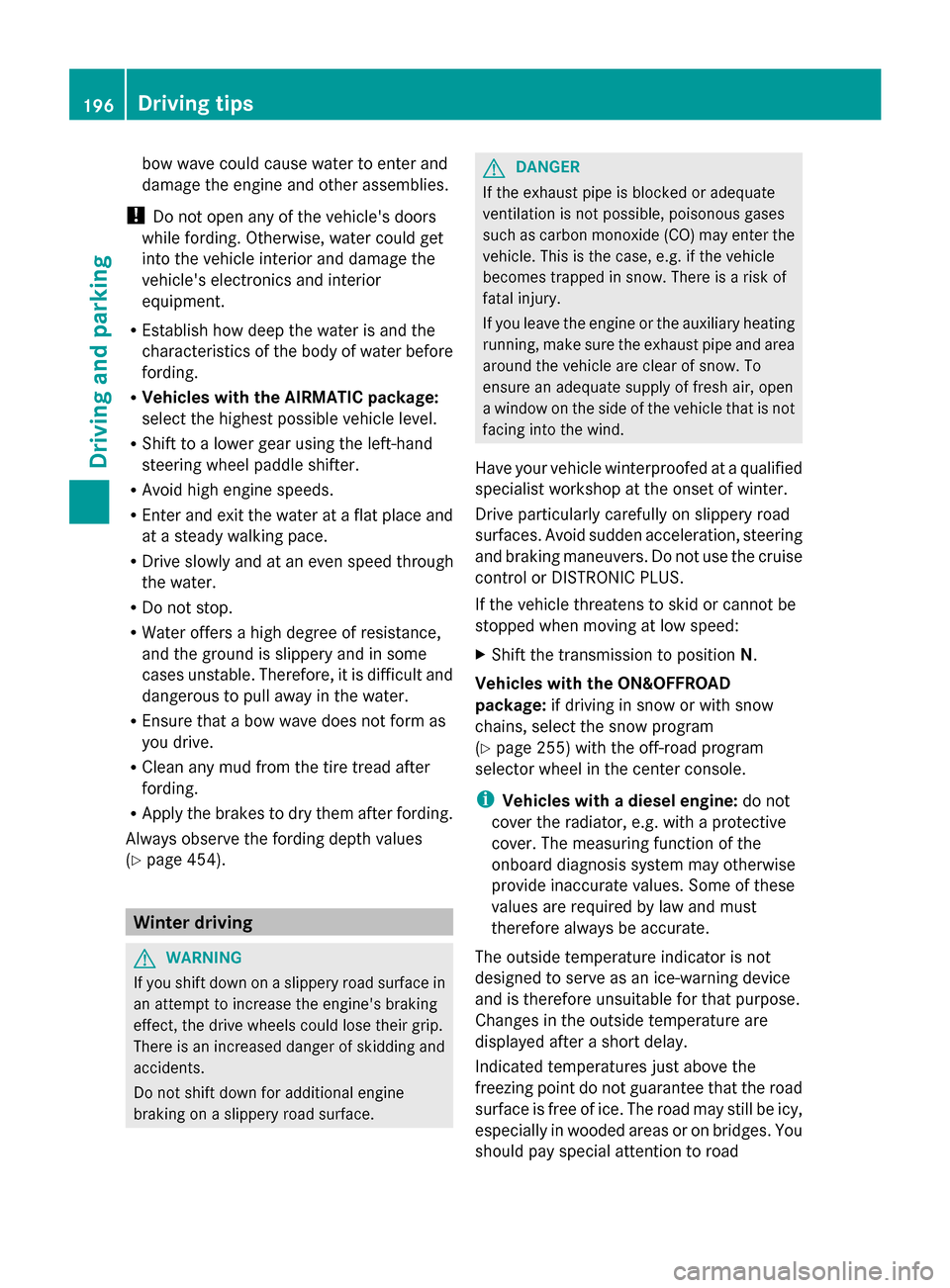
bow wave could cause water to enter and
damage the engine and other assemblies.
! Do not open any of the vehicle's doors
while fording. Otherwise, water could get
into the vehicle interior and damage the
vehicle's electronics and interior
equipment.
R Establish how deep the water is and the
characteristics of the body of water before
fording.
R Vehicles with the AIRMATIC package:
select the highest possible vehicle level.
R Shift to a lower gear using the left-hand
steering wheel paddle shifter.
R Avoid high engine speeds.
R Enter and exit the water at a flat place and
at a steady walking pace.
R Drive slowly and at an even speed through
the water.
R Do not stop.
R Water offers a high degree of resistance,
and the ground is slippery and in some
cases unstable. Therefore, it is difficult and
dangerous to pull away in the water.
R Ensure that a bow wave does not form as
you drive.
R Clean any mud from the tire tread after
fording.
R Apply the brakes to dry them after fording.
Always observe the fording depth values
(Y page 454). Winter driving
G
WARNING
If you shift down on a slippery road surface in
an attempt to increase the engine's braking
effect, the drive wheels could lose their grip.
There is an increased danger of skidding and
accidents.
Do not shift down for additional engine
braking on a slippery road surface. G
DANGER
If the exhaust pipe is blocked or adequate
ventilation is not possible, poisonous gases
such as carbon monoxide (CO) may enter the
vehicle. This is the case, e.g. if the vehicle
becomes trapped in snow. There is a risk of
fatal injury.
If you leave the engine or the auxiliary heating
running, make sure the exhaust pipe and area
around the vehicle are clear of snow. To
ensure an adequate supply of fresh air, open
a window on the side of the vehicle that is not
facing into the wind.
Have your vehicle winterproofed at a qualified
specialist workshop at the onset of winter.
Drive particularly carefully on slippery road
surfaces. Avoid sudden acceleration, steering
and braking maneuvers. Do not use the cruise
control or DISTRONIC PLUS.
If the vehicle threatens to skid or cannot be
stopped when moving at low speed:
X Shift the transmission to position N.
Vehicles with the ON&OFFROAD
package: if driving in snow or with snow
chains, select the snow program
(Y page 255) with the off-road program
selector wheel in the center console.
i Vehicles with a diesel engine: do not
cover the radiator, e.g. with a protective
cover. The measuring function of the
onboard diagnosis system may otherwise
provide inaccurate values. Some of these
values are required by law and must
therefore always be accurate.
The outside temperature indicator is not
designed to serve as an ice-warning device
and is therefore unsuitable for that purpose.
Changes in the outside temperature are
displayed after a short delay.
Indicated temperatures just above the
freezing point do not guarantee that the road
surface is free of ice. The road may still be icy,
especially in wooded areas or on bridges. You
should pay special attention to road 196
Driving tipsDriving and parking
Page 250 of 462
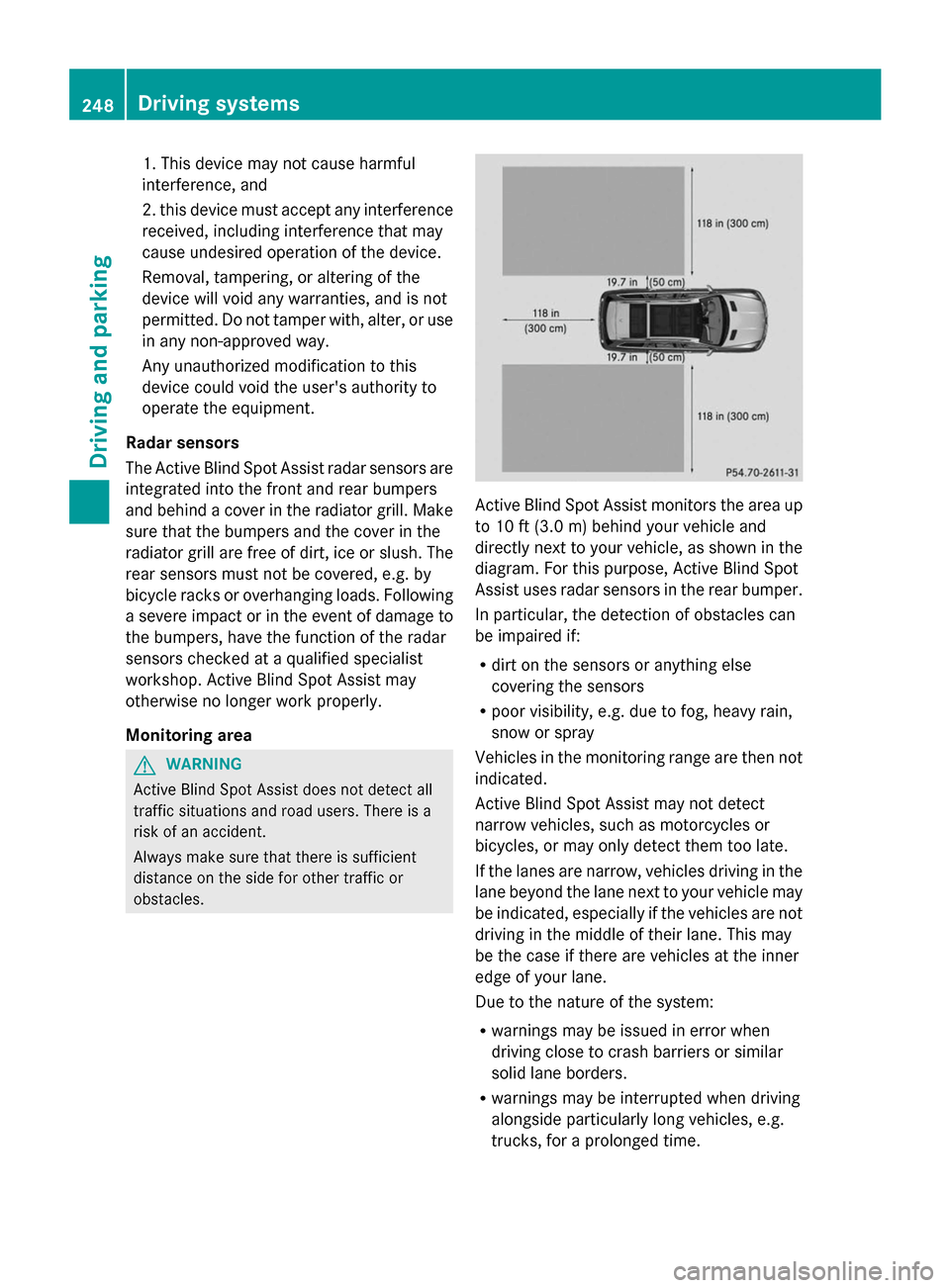
1. This device may not cause harmful
interference, and
2. this device must accept any interference
received, including interference that may
cause undesired operation of the device.
Removal, tampering, or altering of the
device will void any warranties, and is not
permitted. Do not tamper with, alter, or use
in any non-approved way.
Any unauthorized modification to this
device could void the user's authority to
operate the equipment.
Radar sensors
The Active Blind Spot Assist radar sensors are
integrated into the front and rear bumpers
and behind a cover in the radiator grill. Make
sure that the bumpers and the cover in the
radiator grill are free of dirt, ice or slush. The
rear sensors must not be covered, e.g. by
bicycle racks or overhanging loads. Following
a severe impact or in the event of damage to
the bumpers, have the function of the radar
sensors checked at a qualified specialist
workshop. Active Blind Spot Assist may
otherwise no longer work properly.
Monitoring area G
WARNING
Active Blind Spot Assist does not detect all
traffic situations and road users. There is a
risk of an accident.
Always make sure that there is sufficient
distance on the side for other traffic or
obstacles. Active Blind Spot Assist monitors the area up
to 10 ft (3.0 m) behind your vehicle and
directly next to your vehicle, as shown in the
diagram. For this purpose, Active Blind Spot
Assist uses radar sensors in the rear bumper.
In particular, the detection of obstacles can
be impaired if:
R dirt on the sensors or anything else
covering the sensors
R poor visibility, e.g. due to fog, heavy rain,
snow or spray
Vehicles in the monitoring range are then not
indicated.
Active Blind Spot Assist may not detect
narrow vehicles, such as motorcycles or
bicycles, or may only detect them too late.
If the lanes are narrow, vehicles driving in the
lane beyond the lane next to your vehicle may
be indicated, especially if the vehicles are not
driving in the middle of their lane. This may
be the case if there are vehicles at the inner
edge of your lane.
Due to the nature of the system:
R warnings may be issued in error when
driving close to crash barriers or similar
solid lane borders.
R warnings may be interrupted when driving
alongside particularly long vehicles, e.g.
trucks, for a prolonged time. 248
Driving systemsDriving and parking
Page 301 of 462

Display messages Possible causes/consequences and
M
MSolutions PRE-SAFE
PRE-SAFE
Functions Functions
Currently Limited Currently Limited
See Operator's See Operator's
Manual Manual Vehicles with the Active Driving Assistance package:
PRE-SAFE
®
Brake is temporarily inoperative. Possible causes are:
R function is impaired due to heavy rain or snow.
R the sensors in the radiator grill and the bumper are dirty.
R the radar sensor system is temporarily inoperative, e.g. due to
electromagnetic radiation emitted by nearby TV or radio
stations or other sources of electromagnetic radiation.
R AMG vehicles: ESP ®
is deactivated.
R the system is outside the operating temperature range.
R the on-board voltage is too low.
When the causes stated above no longer apply, the display
message disappears.
PRE-SAFE ®
Brake is operational again.
If the display message does not disappear:
X Pull over and stop the vehicle safely as soon as possible, paying
attention to road and traffic conditions.
X Secure the vehicle against rolling away ( Ypage 188).
X Clean the sensors in the radiator grill and the bumper
(Y page 380).
X Restart the engine.
X AMG vehicles: reactivate ESP ®
(Y page 73). PRE-SAFE PRE-SAFE
Functions Functions
Currently Limited Currently Limited
See Operator's See Operator's
Manual Manual Vehicles without the Active Driving Assistance package: Adaptive
Brake Assist is faulty. The distance warning function may also have
failed.
Vehicles with the Active Driving Assistance package:
PRE-SAFE
®
Brake is faulty. BAS PLUS or the distance warning
function may also have failed.
X Visit a qualified specialist workshop. 6
SRS Malfunction SRS Malfunction
Service Required Service Required There is a malfunction in the SRS (Supplemental Restraint
System).
The
6 warning lamp also lights up in the instrument cluster.
G WARNING
The air bags or Emergency Tensioning Devices may either be
triggered unintentionally or, in the event of an accident, may not
be triggered.
There is an increased risk of injury.
X Visit a qualified specialist workshop.
Further information on occupant safety (Y page 43). Display
messages
299On-board computer and displays Z
Page 309 of 462
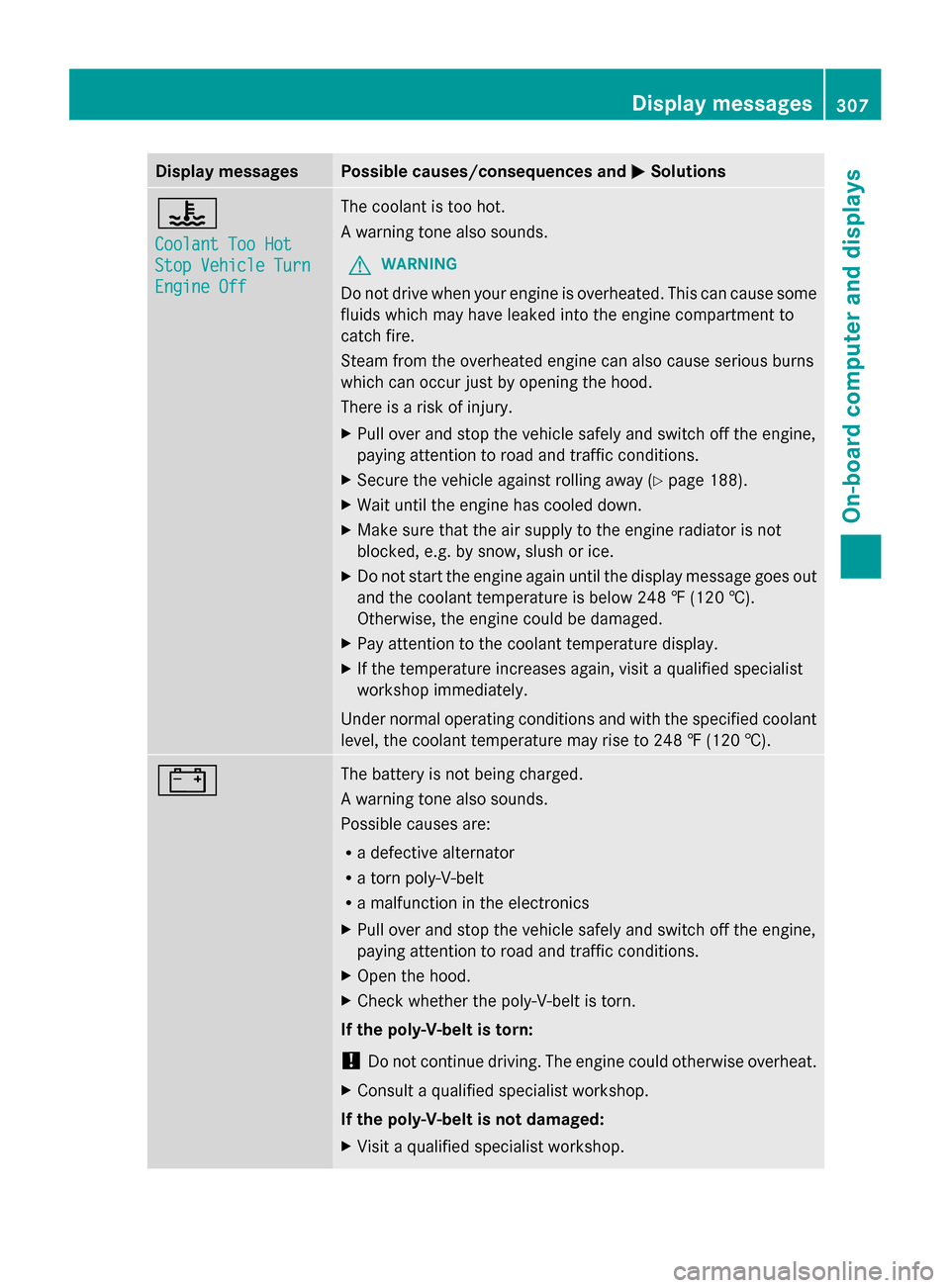
Display messages Possible causes/consequences and
M
MSolutions ?
Coolant Too Hot Coolant Too Hot
Stop Vehicle Turn Stop Vehicle Turn
Engine Off Engine Off The coolant is too hot.
A warning tone also sounds.
G WARNING
Do not drive when your engine is overheated. This can cause some
fluids which may have leaked into the engine compartment to
catch fire.
Steam from the overheated engine can also cause serious burns
which can occur just by opening the hood.
There is a risk of injury.
X Pull over and stop the vehicle safely and switch off the engine,
paying attention to road and traffic conditions.
X Secure the vehicle against rolling away ( Ypage 188).
X Wait until the engine has cooled down.
X Make sure that the air supply to the engine radiator is not
blocked, e.g. by snow, slush or ice.
X Do not start the engine again until the display message goes out
and the coolant temperature is below 248 ‡ (120 †).
Otherwise, the engine could be damaged.
X Pay attention to the coolant temperature display.
X If the temperature increases again, visit a qualified specialist
workshop immediately.
Under normal operating conditions and with the specified coolant
level, the coolant temperature may rise to 248 ‡ (120 †). # The battery is not being charged.
A warning tone also sounds.
Possible causes are:
R
a defective alternator
R a torn poly-V-belt
R a malfunction in the electronics
X Pull over and stop the vehicle safely and switch off the engine,
paying attention to road and traffic conditions.
X Open the hood.
X Check whether the poly-V-belt is torn.
If the poly-V-belt is torn:
! Do not continue driving. The engine could otherwise overheat.
X Consult a qualified specialist workshop.
If the poly-V-belt is not damaged:
X Visit a qualified specialist workshop. Display
messages
307On-board computer and displays Z
Page 318 of 462
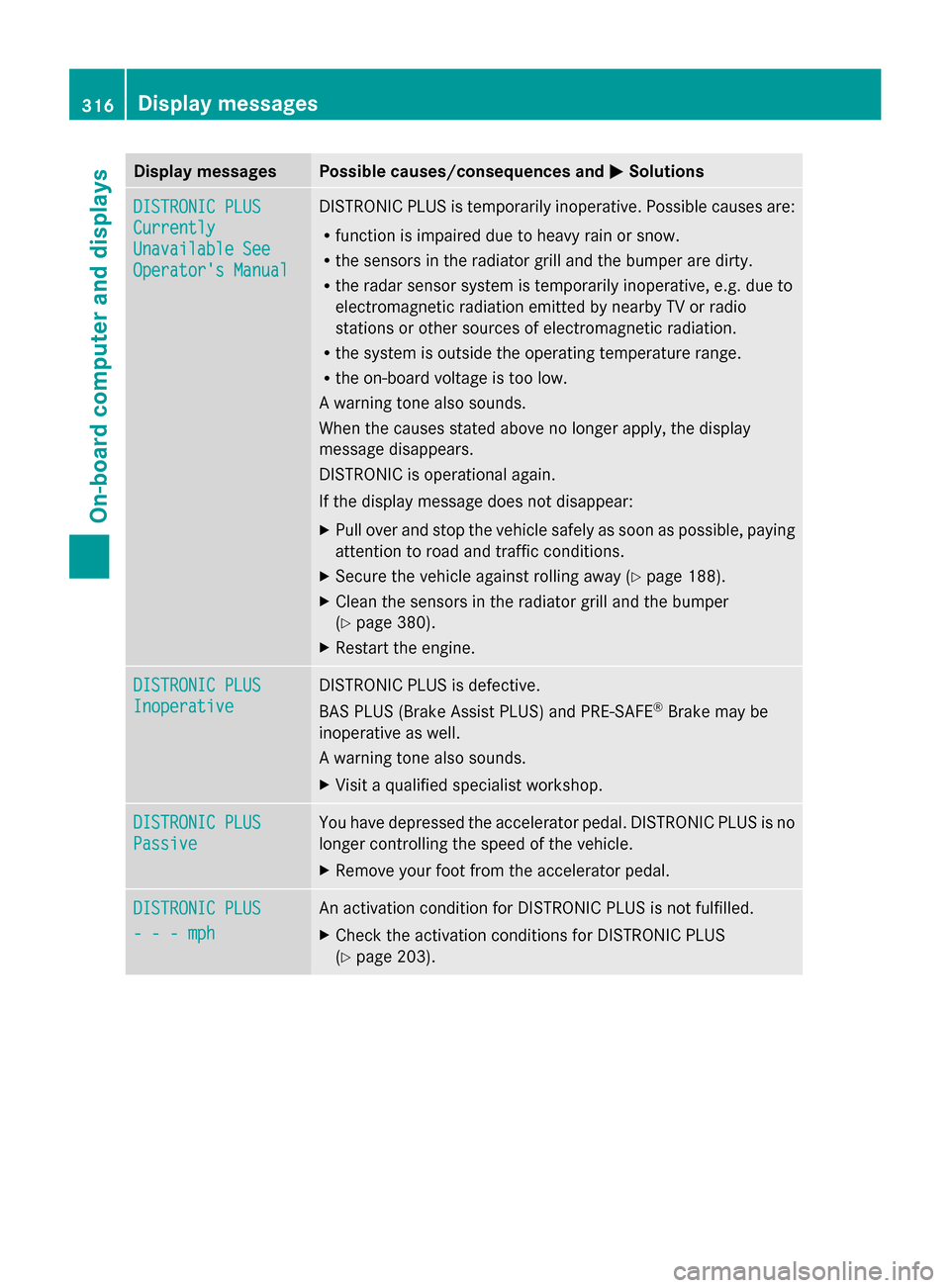
Display messages Possible causes/consequences and
M
MSolutions DISTRONIC PLUS
DISTRONIC PLUS
Currently Currently
Unavailable See Unavailable See
Operator's Manual Operator's Manual DISTRONIC PLUS is temporarily inoperative. Possible causes are:
R
function is impaired due to heavy rain or snow.
R the sensors in the radiator grill and the bumper are dirty.
R the radar sensor system is temporarily inoperative, e.g. due to
electromagnetic radiation emitted by nearby TV or radio
stations or other sources of electromagnetic radiation.
R the system is outside the operating temperature range.
R the on-board voltage is too low.
A warning tone also sounds.
When the causes stated above no longer apply, the display
message disappears.
DISTRONIC is operational again.
If the display message does not disappear:
X Pull over and stop the vehicle safely as soon as possible, paying
attention to road and traffic conditions.
X Secure the vehicle against rolling away ( Ypage 188).
X Clean the sensors in the radiator grill and the bumper
(Y page 380).
X Restart the engine. DISTRONIC PLUS DISTRONIC PLUS
Inoperative Inoperative DISTRONIC PLUS is defective.
BAS PLUS (Brake Assist PLUS) and PRE-SAFE
®
Brake may be
inoperative as well.
A warning tone also sounds.
X Visit a qualified specialist workshop. DISTRONIC PLUS DISTRONIC PLUS
Passive Passive You have depressed the accelerator pedal. DISTRONIC PLUS is no
longer controlling the speed of the vehicle.
X
Remove your foot from the accelerator pedal. DISTRONIC PLUS DISTRONIC PLUS
- - - mph - - - mph An activation condition for DISTRONIC PLUS is not fulfilled.
X
Check the activation conditions for DISTRONIC PLUS
(Y page 203). 316
Display
messagesOn-board computer and displays
Page 337 of 462
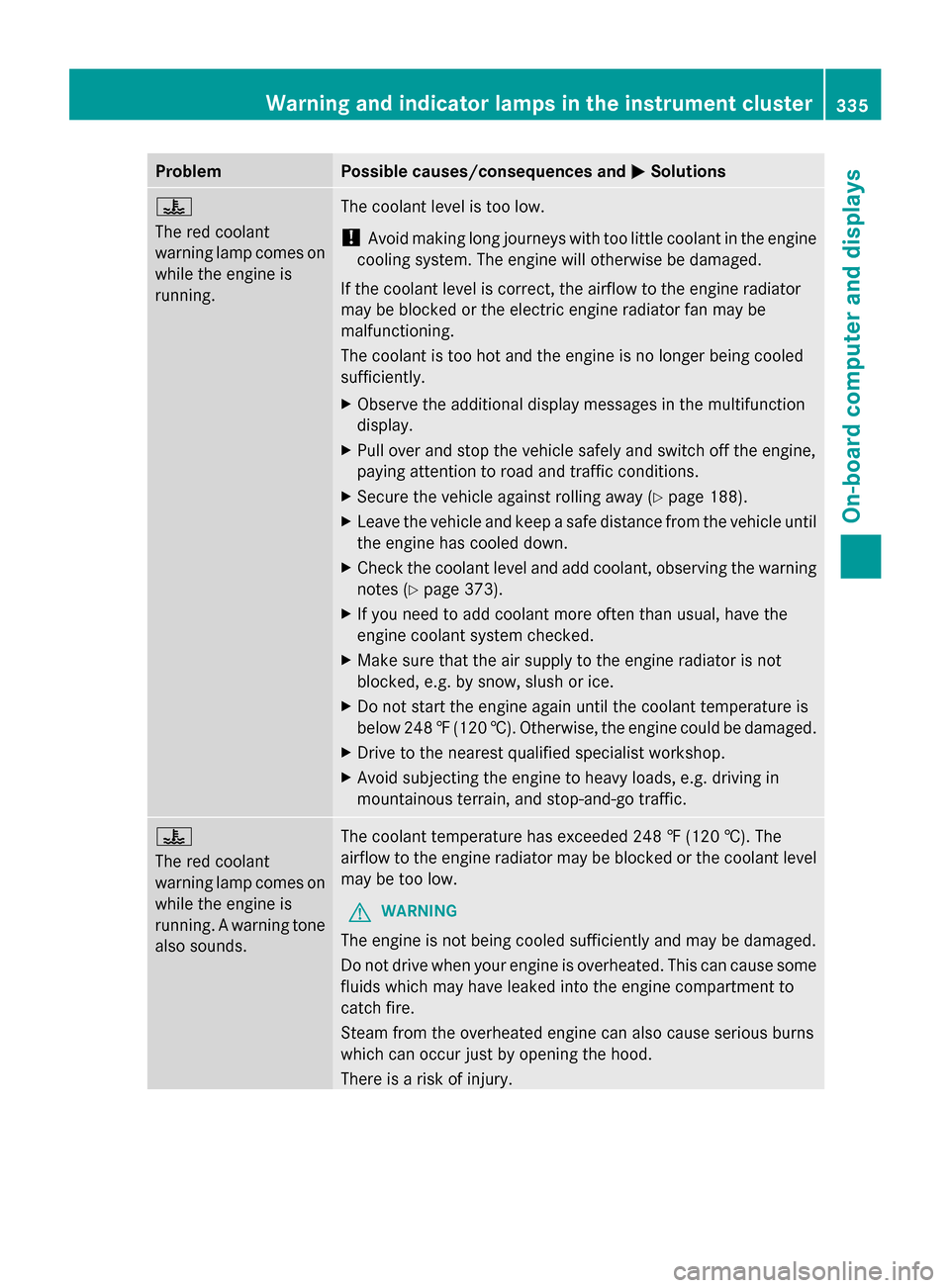
Problem Possible causes/consequences and
M
MSolutions ?
The red coolant
warning lamp comes on
while the engine is
running.
The coolant level is too low.
!
Avoid making long journeys with too little coolant in the engine
cooling system. The engine will otherwise be damaged.
If the coolant level is correct, the airflow to the engine radiator
may be blocked or the electric engine radiator fan may be
malfunctioning.
The coolant is too hot and the engine is no longer being cooled
sufficiently.
X Observe the additional display messages in the multifunction
display.
X Pull over and stop the vehicle safely and switch off the engine,
paying attention to road and traffic conditions.
X Secure the vehicle against rolling away (Y page 188).
X Leave the vehicle and keep a safe distance from the vehicle until
the engine has cooled down.
X Check the coolant level and add coolant, observing the warning
notes (Y page 373).
X If you need to add coolant more often than usual, have the
engine coolant system checked.
X Make sure that the air supply to the engine radiator is not
blocked, e.g. by snow, slush or ice.
X Do not start the engine again until the coolant temperature is
below 248 ‡(120 †). Otherwise, the engine could be damaged.
X Drive to the nearest qualified specialist workshop.
X Avoid subjecting the engine to heavy loads, e.g. driving in
mountainous terrain, and stop-and-go traffic. ?
The red coolant
warning lamp comes on
while the engine is
running. A warning tone
also sounds.
The coolant temperature has exceeded 248 ‡ (120 †). The
airflow to the engine radiator may be blocked or the coolant level
may be too low.
G WARNING
The engine is not being cooled sufficiently and may be damaged.
Do not drive when your engine is overheated. This can cause some
fluids which may have leaked into the engine compartment to
catch fire.
Steam from the overheated engine can also cause serious burns
which can occur just by opening the hood.
There is a risk of injury. Warning and indicator lamps in the instrument cluster
335On-board computer and displays Z
Page 338 of 462

Problem Possible causes/consequences and
M
MSolutions X
Observe the additional display messages in the multifunction
display.
X Pull over and stop the vehicle safely and switch off the engine,
paying attention to road and traffic conditions.
X Secure the vehicle against rolling away (Y page 188).
X Leave the vehicle and keep a safe distance from the vehicle until
the engine has cooled down.
X Check the coolant level and add coolant, observing the warning
notes (Y page 373).
X If you need to add coolant more often than usual, have the
engine coolant system checked.
X Make sure that the air supply to the engine radiator is not
blocked, e.g. by snow, slush or ice.
X At coolant temperatures below 248 ‡ (120 †), drive to the
nearest qualified specialist workshop.
X Avoid subjecting the engine to heavy loads, e.g. driving in
mountainous terrain, and stop-and-go traffic. Driving systems
Problem Possible causes/consequences and
M MSolutions ·
The red distance
warning function
warning lamp comes on
while the vehicle is
moving. A warning tone
also sounds.
You are approaching a vehicle or a stationary obstacle in your line
of travel at too high a speed.
X
Be prepared to brake immediately.
X Pay careful attention to the traffic situation. You may have to
brake or take evasive action.
Further information on DISTRONIC PLUS (Y page 203).
Further information on PRE-SAFE ®
Brake (Y page 75).
Further information on the distance warning function
(Y page 69). 336
Warning and indicator lamps in the instrument clusterOn-board computer and displays